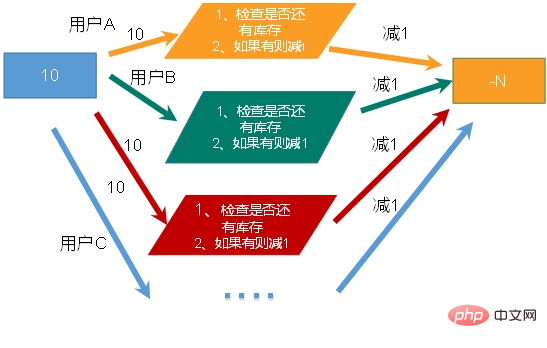Let's talk about the issue of realizing flash sales with Redis
This article brings you relevant knowledge about Redis, which mainly introduces the relevant content about realizing flash sales, including flash sale logic, existing link timeouts, overselling and inventory legacy Let’s take a look at the problem below. I hope it will be helpful to everyone.

Recommended learning: Redis video tutorial
1. Flash sale logic
Second sale : Solve the transaction operations of counters and personnel records
- ##1. Judgment that uid and proid are not empty
- 2. Connect to redis
- 3. Splicing key
- Inventory key
- Successful flash sale user key
4. Get the inventory. If the inventory is null, the flash sale has not started yet- 5. Determine whether the user repeats the flash sale operation
- 6. Determine the quantity of the product. If the inventory quantity is less than 1, the flash sale ends
- 7. Flash sale process
- Inventory-1
- Add users who have successfully flash killed to the list

3.1. Connection timeoutUse connection pool, the tool class is as follows:
public class JedisPoolUtil {
private static volatile JedisPool jedisPool = null;
private JedisPoolUtil() {
}
public static JedisPool getJedisPoolInstance() {
if (null == jedisPool) {
synchronized (JedisPoolUtil.class) {
if (null == jedisPool) {
JedisPoolConfig poolConfig = new JedisPoolConfig();
poolConfig.setMaxTotal(200);
poolConfig.setMaxIdle(32);
poolConfig.setMaxWaitMillis(100 * 1000);
poolConfig.setBlockWhenExhausted(true);
poolConfig.setTestOnBorrow(true);
jedisPool = new JedisPool(poolConfig, "127.0.0.1", 6379, 60000);
}
}
}
return jedisPool;
}}//使用JedisPool jedisPoolInstance = JedisPoolUtil.getJedisPoolInstance();Jedis jedis = jedisPoolInstance.getResource();
<dependency> <groupid>org.springframework.boot</groupid> <artifactid>spring-boot-starter-data-redis</artifactid></dependency><dependency> <groupid>redis.clients</groupid> <artifactid>jedis</artifactid> <version>3.2.0</version></dependency>
spring: redis: host: 127.0.0.1 port: 6379 database: 0 timeout: 1800000 lettuce: pool: max-active: 20 max-wait: -1 max-idle: 5 min-idle: 0
@Autowired private RedisTemplate redisTemplate;
//监视库存
jedis.watch(kcKey);//中间代码忽略
//7 秒杀过程
//使用事务
Transaction multi = jedis.multi();//组队操作
multi.decr(kcKey);multi.sadd(userKey,uid);//执行
List<object> results = multi.exec();if(results == null || results.size()==0) {
System.out.println("秒杀失败了....");
jedis.close();
return false;}</object>- Write complex or multi-step Redis operations as a script and submit it to Redis for execution at one time to reduce the number of repeated connections to redis. Improve performance.
- LUA script is similar to a redis transaction. It has a certain degree of atomicity and will not be queued by other commands. It can complete redis transactional operations.
- LUA script function is only available in Redis 2.6 or above. You can use
- to use lua scripts to eliminate users and solve the overselling problem.
- After version 2.6 of redis, the contention problem is solved through
- lua script. In fact, redis uses its single-threaded feature to solve the multi-task concurrency problem using a task queue.
local userid=KEYS[1]; //1、2行定义两个变量,
local prodid=KEYS[2];
local qtkey="sk:"..prodid..":qt"; //3,4行定义拼接key
local usersKey="sk:"..prodid..":usr";
local userExists=redis.call("sismember",usersKey,userid); //5-8,判断用户是否存在,不存在return 2
if tonumber(userExists)==1 then
return2;
end
local num=redis.call("get",qtkey); //9-11,判断商品是否存在
if tonumber(num)// 定义两段Lua脚本(使用Lua脚本可以解决乐观锁带来的库存遗留问题) static String secKillScript = "local userid=KEYS[1];\r\n" + "local prodid=KEYS[2];\r\n" + "local qtkey='sk:'..prodid..\":qt\";\r\n" + "local usersKey='sk:'..prodid..\":usr\";\r\n" + "local userExists=redis.call(\"sismember\",usersKey,userid);\r\n" + "if tonumber(userExists)==1 then \r\n" + " return 2;\r\n" + "end\r\n" + "local num= redis.call(\"get\" ,qtkey);\r\n" + "if tonumber(num)Recommended learning: <p>Redis video tutorial<a href="https://www.php.cn/course/list/54.html" target="_blank"></a></p>
The above is the detailed content of Let's talk about the issue of realizing flash sales with Redis. For more information, please follow other related articles on the PHP Chinese website!

Hot AI Tools

Undresser.AI Undress
AI-powered app for creating realistic nude photos

AI Clothes Remover
Online AI tool for removing clothes from photos.

Undress AI Tool
Undress images for free

Clothoff.io
AI clothes remover

Video Face Swap
Swap faces in any video effortlessly with our completely free AI face swap tool!

Hot Article

Hot Tools

Notepad++7.3.1
Easy-to-use and free code editor

SublimeText3 Chinese version
Chinese version, very easy to use

Zend Studio 13.0.1
Powerful PHP integrated development environment

Dreamweaver CS6
Visual web development tools

SublimeText3 Mac version
God-level code editing software (SublimeText3)

Hot Topics
 How to build the redis cluster mode
Apr 10, 2025 pm 10:15 PM
How to build the redis cluster mode
Apr 10, 2025 pm 10:15 PM
Redis cluster mode deploys Redis instances to multiple servers through sharding, improving scalability and availability. The construction steps are as follows: Create odd Redis instances with different ports; Create 3 sentinel instances, monitor Redis instances and failover; configure sentinel configuration files, add monitoring Redis instance information and failover settings; configure Redis instance configuration files, enable cluster mode and specify the cluster information file path; create nodes.conf file, containing information of each Redis instance; start the cluster, execute the create command to create a cluster and specify the number of replicas; log in to the cluster to execute the CLUSTER INFO command to verify the cluster status; make
 How to clear redis data
Apr 10, 2025 pm 10:06 PM
How to clear redis data
Apr 10, 2025 pm 10:06 PM
How to clear Redis data: Use the FLUSHALL command to clear all key values. Use the FLUSHDB command to clear the key value of the currently selected database. Use SELECT to switch databases, and then use FLUSHDB to clear multiple databases. Use the DEL command to delete a specific key. Use the redis-cli tool to clear the data.
 How to read redis queue
Apr 10, 2025 pm 10:12 PM
How to read redis queue
Apr 10, 2025 pm 10:12 PM
To read a queue from Redis, you need to get the queue name, read the elements using the LPOP command, and process the empty queue. The specific steps are as follows: Get the queue name: name it with the prefix of "queue:" such as "queue:my-queue". Use the LPOP command: Eject the element from the head of the queue and return its value, such as LPOP queue:my-queue. Processing empty queues: If the queue is empty, LPOP returns nil, and you can check whether the queue exists before reading the element.
 How to configure Lua script execution time in centos redis
Apr 14, 2025 pm 02:12 PM
How to configure Lua script execution time in centos redis
Apr 14, 2025 pm 02:12 PM
On CentOS systems, you can limit the execution time of Lua scripts by modifying Redis configuration files or using Redis commands to prevent malicious scripts from consuming too much resources. Method 1: Modify the Redis configuration file and locate the Redis configuration file: The Redis configuration file is usually located in /etc/redis/redis.conf. Edit configuration file: Open the configuration file using a text editor (such as vi or nano): sudovi/etc/redis/redis.conf Set the Lua script execution time limit: Add or modify the following lines in the configuration file to set the maximum execution time of the Lua script (unit: milliseconds)
 How to set the redis expiration policy
Apr 10, 2025 pm 10:03 PM
How to set the redis expiration policy
Apr 10, 2025 pm 10:03 PM
There are two types of Redis data expiration strategies: periodic deletion: periodic scan to delete the expired key, which can be set through expired-time-cap-remove-count and expired-time-cap-remove-delay parameters. Lazy Deletion: Check for deletion expired keys only when keys are read or written. They can be set through lazyfree-lazy-eviction, lazyfree-lazy-expire, lazyfree-lazy-user-del parameters.
 How to use the redis command line
Apr 10, 2025 pm 10:18 PM
How to use the redis command line
Apr 10, 2025 pm 10:18 PM
Use the Redis command line tool (redis-cli) to manage and operate Redis through the following steps: Connect to the server, specify the address and port. Send commands to the server using the command name and parameters. Use the HELP command to view help information for a specific command. Use the QUIT command to exit the command line tool.
 How to optimize the performance of debian readdir
Apr 13, 2025 am 08:48 AM
How to optimize the performance of debian readdir
Apr 13, 2025 am 08:48 AM
In Debian systems, readdir system calls are used to read directory contents. If its performance is not good, try the following optimization strategy: Simplify the number of directory files: Split large directories into multiple small directories as much as possible, reducing the number of items processed per readdir call. Enable directory content caching: build a cache mechanism, update the cache regularly or when directory content changes, and reduce frequent calls to readdir. Memory caches (such as Memcached or Redis) or local caches (such as files or databases) can be considered. Adopt efficient data structure: If you implement directory traversal by yourself, select more efficient data structures (such as hash tables instead of linear search) to store and access directory information
 How to implement redis counter
Apr 10, 2025 pm 10:21 PM
How to implement redis counter
Apr 10, 2025 pm 10:21 PM
Redis counter is a mechanism that uses Redis key-value pair storage to implement counting operations, including the following steps: creating counter keys, increasing counts, decreasing counts, resetting counts, and obtaining counts. The advantages of Redis counters include fast speed, high concurrency, durability and simplicity and ease of use. It can be used in scenarios such as user access counting, real-time metric tracking, game scores and rankings, and order processing counting.






